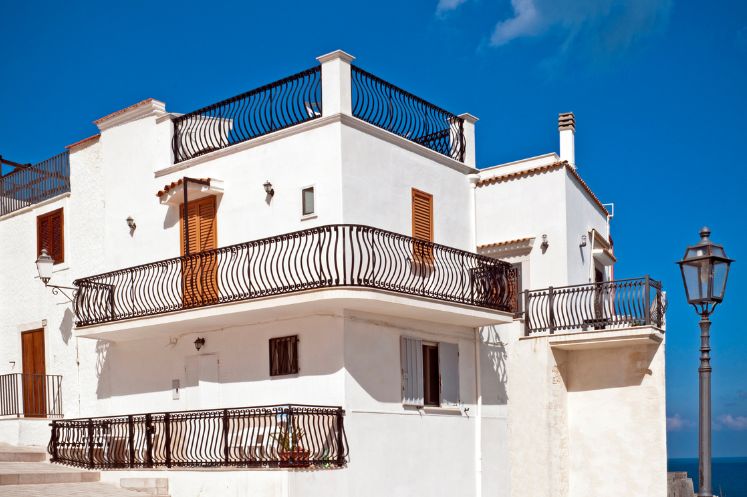The Mediterranean climate is characterised by mild, rainy winters and hot, dry summers. Therefore, when designing a house in this region, it is essential to consider certain architectural features that not only improve the comfort of its inhabitants, but also optimise energy consumption and the use of resources. Below, we explore the key aspects that a house should have to adapt to Mediterranean climates.
1. Orientation and distribution of spaces
1.1 Importance of guidance
The orientation of the house is crucial to maximise energy efficiency. The main rooms, such as the living room and bedrooms, should face south or south-east. This allows natural sunlight to enter during the day, which efficiently warms the interior in winter. At the same time, orientations that receive direct sunlight in summer should be avoided, thus reducing the need for air conditioning.
1.2 Cross ventilation
Good room layout is essential to promote cross-ventilation. The correct arrangement of windows and doors allows fresh air to circulate freely, maintaining comfortable temperatures without the need for artificial cooling systems. This not only improves indoor air quality, but also contributes to a healthier and more comfortable environment.
Contact our architectural firm
2. Thermal insulation
Good insulation is essential to maintain a comfortable indoor temperature. Using materials with high insulating capacity in walls, ceilings and floors helps to keep warmth in winter and avoid overheating in summer. This results in lower energy consumption and more efficient heating and cooling systems.
2.1 Recommended materials
Materials such as stone, ceramic or plaster are ideal choices, as they offer a traditional and functional aesthetic. In addition, these materials have thermal properties that allow the interior temperature to be regulated, guaranteeing a more sustainable home. It is essential to choose quality materials that ensure durability and effective insulation.
3. Suitable covers
3.1 Roof design
The roofs of houses in Mediterranean climates must be designed to withstand high temperatures. Gable roofs or roofs with wide overhangs not only contribute to the aesthetics of the house, but also provide shade and solar protection. These elements help to reduce exposure to the sun, keeping the interior cooler during the hot months.
3.2 Choice of materials
Choosing ceramic tiles or reflective materials is an excellent strategy to reduce indoor heat build-up. These materials are able to reflect solar radiation, which helps to maintain a more comfortable indoor temperature. In addition, well-designed roofs prevent problems with leaks and moisture build-up.
4. Use of patios and outdoor spaces
Patios and outdoor spaces are an integral part of Mediterranean architecture. These spaces not only provide areas for shade and relaxation, but also allow for the circulation of fresh air. By integrating outdoor spaces into the design, a healthier and more active lifestyle is promoted, where residents can enjoy nature and the climate.
4.1 Integration of vegetation
Integrating gardens and greenery into the design can help keep the house cooler, as well as providing a natural and welcoming environment. Plants not only act as natural insulators, but also contribute to improved air quality and biodiversity. A well-designed garden can become a haven of peace and relaxation in the home.
5. Windows and enclosures
5.1 Importance of windows
Windows are essential for natural lighting and ventilation. In Mediterranean climates, it is advisable to opt for large windows that can be opened completely, allowing good air circulation. In addition, it is advisable to use low emissivity glass that reduces heat transfer, keeping the home comfortable all year round.
5.2 Sunlight regulation
Incorporating blinds or awnings can help to regulate the entry of direct sunlight and reduce indoor heat. These elements not only improve the energy efficiency of the home, but also provide privacy and control over brightness. Choosing appropriate shading systems is essential for the comfort of residents.
6. Energy efficient systems
Finally, incorporating energy efficient systems, such as solar panels, can be an excellent option to take advantage of natural resources and reduce energy consumption. These systems make it possible to use solar energy to meet part of the home’s energy needs, which translates into significant savings on bills.
6.1 Rainwater harvesting
The installation of rainwater harvesting systems is also recommended to maximise the use of water resources. This system not only reduces the consumption of drinking water, but also helps to keep gardens and outdoor spaces in optimal conditions. It also encourages more sustainable and environmentally responsible practices.
In short, designing a house adapted to Mediterranean climates involves considering a series of architectural features that optimise comfort and energy efficiency. At Velló Monfort Arquitectes, our studio in Gandía specialises in creating spaces that are not only functional and aesthetically pleasing, but also respect the environment and adapt to the needs of their inhabitants. If you are thinking of building or renovating your home in this beautiful region, contact us for more information!


